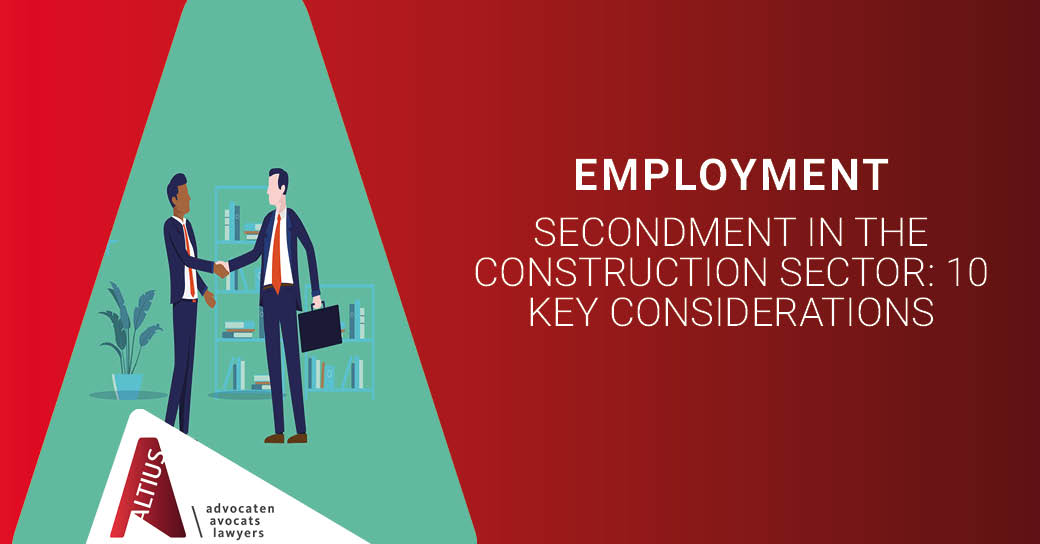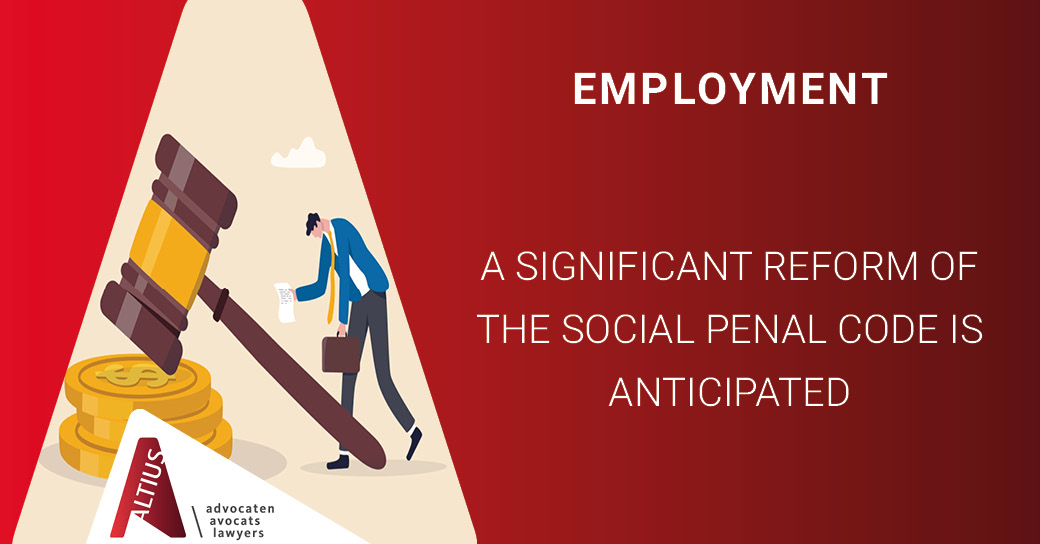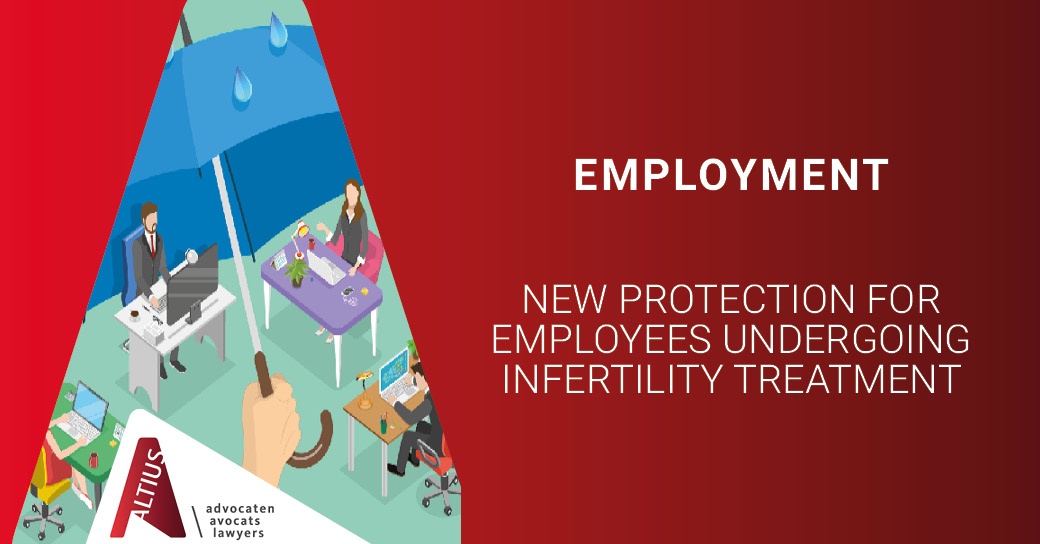Secondment in the construction sector: 10 key considerations

The construction sector is a fraud-sensitive sector. Belgian companies that are working with foreign subcontractors and foreign companies seconding their employees to Belgium to work on a project in Belgium must comply with general employment-related obligations and also with obligations that are specific to the construction sector.
This article highlights the most notable obligations and corresponding liabilities for secondment in the construction sector.
1. Requirement of a residence and work permit
Non EEA-employees (EEA – European Economic Area) must obtain a residence and work permit (for employment of less than 90 days) or a so-called combined single permit (for employment beyond 90 days) to perform professional activities in Belgium.
Such permits must be requested well in advance, since the procedure can take up to 120 days (and can even be extended in certain exceptional circumstances).
However, exceptions to the obligation to obtain a work permit may apply, such as for specialised technicians who come to Belgium to assemble, start up or repair an installation manufactured or supplied by their foreign employer and when such work is for up to a maximum period of eight days.
2. Social Security: A1-form or Certificate of Coverage required
EEA-employees on secondment in Belgium will remain covered by their foreign social security system, provided that the secondment in Belgium does not exceed two years. This period may be extended up to a maximum of five years in total. A so-called A1-form must be filed, in principle, before commencing the works in Belgium.
Non-EEA employees will have to obtain a Certificate of Coverage from their home country. This is only possible in case of a bilateral agreement between the respective countries. To prevent submission to the Belgian social security system, it is therefore important to verify whether a bilateral agreement exists between the respective countries.
If the foreign employee does not have such an A1-form or Certificate of Coverage, such absence can trigger payment of employer’s and employee’s social security contributions in Belgium
3. LIMOSA-declaration
A foreign employer must file a so-called ‘LIMOSA’-declaration with the Belgian National Social Security Office for all employees who normally work in a foreign country (including the EEA) or are hired in a foreign country and who temporarily or partially come to work in Belgium (i.e. for a secondment).
A self-employed person must also file a LIMOSA-declaration for activities in the construction sector in Belgium.
4. Obligation to appoint a contact person in Belgium to liaise with the social inspection services
Each foreign employer assigning employees to Belgium is obliged to appoint a contact person with whom the competent authorities and social inspection services can communicate before the start of the activities. Such a person’s identity must be notified to the Belgian social inspection services via the LIMOSA-declaration.
5. Obligation to comply with Belgian ‘hard core’ employment rights
A foreign employer posting workers to Belgium must, for the work carried out in Belgium, comply with (i) the labour, salary and employment requirements of Belgian statutory provisions of which non-compliance is subject to criminal penalties (the vast majority of requirements), and with (ii) sectoral CBAs (Collective Bargaining Agreements) that have been declared as generally binding by Royal Decree. Consequently, foreign companies must comply with the Belgian regulations for, amongst other things, working time and rest periods, minimum wages, health and safety, etc.
6. Watch out for unlawful employee-lending in subcontracting-chains
Subcontracting-chains are regularly used in the construction sector. Such subcontracting-chains might lead to prohibited labour leasing. Labour leasing is a situation whereby an employer makes its own employee available to a third party and the latter exercises over that employee a part of an employer’s authority that is normally exercised by the actual employer.
The risks of prohibited labour leasing can be limited by entering into a service agreement between the original employer, as the ‘service provider’, and the Belgian company that will use the employee, as the ‘service user’. In such a service agreement, a list of ‘operational instructions’ that the service user can give (or should not give) to the service provider’s employees must be included.
7. Joint liability for the payment of salary of the (sub)contractor’s employees
In the construction sector, there are 2 types of joint liability for the payment of the (sub)contractor’s employees’ salaries, i.e.:
- the automatic joint liability of the principal for the non-payment of salary by its direct contractor. The same applies for the contractor vis-à-vis its direct subcontractor. This liability can be avoided by means of a written declaration signed by both parties in which the (sub)contractor confirms its compliance with the obligation to pay salary and in which a reference is made to the website www.minimumlonen.be / www.salairesminimums.be;
- the joint liability up to the principal from the 14th working day following a notification by the social inspection service regarding the non-payment of salary by a (sub)contractor(s). To avoid this joint liability, it is advised to make contractual arrangements regarding the consequences in case the social inspection issues such a notification (such as a condition subsequent or an early termination possibility without any notice period or indemnity).
8. Withholding obligation for the (sub)contractors’ social debts
For the (sub)contractor’s(s’) social debts, the principal is obliged to withhold and pay 35% of each invoice to the Belgian National Social Security Office. If the principal does not withhold these amounts, it will be considered as jointly liable for the payment of these social debts as its contractor or even for the social debts of any subcontractor in the further subcontracting-chain. The same applies for the contractor vis-à-vis its direct subcontractor.
To avoid the withholding obligation and subsequent joint liability, the company must verify whether the subcontractor has any social debts on the website: www.checkinhoudingsplicht.be / www.checkobligationderetenue.be and this should happen at both the time that the service agreement is entered into and the time of the invoice payment.
The withholding obligation does not apply in case of a foreign (sub)contractor who has no social debts and whose employees are all covered by an A1-form (see above).
9. Declaration of work
For projects above EUR 30,000 (excluding VAT) with or without any subcontractors and for projects above EUR 5,000 with at least one subcontractor, a so-called ‘declaration of work’ must be filed with the Belgian National Social Security Office by the (main) contractor before the work starts. If not, the (main) contractor is liable for the payment of a fine equal to 5% of the total amount of the work.
10. Checkinatwork
For projects for which the total cost amounts to a minimum of EUR 500,000, the presence of anyone who performs work on the project (i.e. (foreign) employees, (sub)contractors, employees of (sub)contractors, etc.) must be registered by means of an electronic presence recording system. This is called ‘Checkinatwork’. The construction sites for which Checkinatwork applies must also be declared in the ‘declaration of works’.
When seconding employees to Belgium to work in the construction sector, both the foreign company/contractor and the Belgian principal should verify whether all the obligations set out above are complied with. Compliance is now even more important as the Belgian social inspection service is increasingly focusing on this fraud-sensitive sector.
Recommended articles
Internal investigations: an employee’s right to be assisted during an interview.
Although employers have been proceeding with internal investigations for decades, nowadays they raise more and more legal questions. Driven by legislative initiatives and case law trends, there are many situations in which an employer may be forced to an internal investigation.
Read onA significant reform of the Social Penal Code is anticipated
A new draft Act has recently been submitted to the Belgian Parliament that aims to amend the Social Penal Code which lists the infringements of labour and social security law that are punishable and the related penalties.
Read onNew protection for employees undergoing infertility treatment
The Belgian Parliament has adopted a new Act to better protect employees undergoing infertility treatment. The new Act aims to protect these employees against (i) dismissal, and (ii) discrimination. It therefore updates two well-known Belgian employment law Acts: the Labour Act of 16 March 1971 and the Gender Act of 10 May 2007.
Read on

